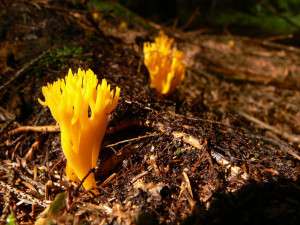Genome sequences of early-diverging fungi help track origins of white rot fungi

Researchers utilized draft genome sequences of 10 white rot and brown rot fungi representing early-diverging groups to help refine the timeline that dates the enzymatic origins of lignocellulose decomposition.
Fungi are natural degraders of plant material and contain enzymes that biofuels researchers hope to harness for commercial applications. Studying the enzyme families in white rot and brown rot fungal genome sequences allows researchers to fill in gaps in the fungal evolutionary timeline and provide more precise timestamps for when various species might have gained the ability to break down all woody components in plant cell walls.
Biofuels researchers are interested in wood-decaying fungi because their enzymes allow them to break down plant materials such as cellulose, hemicellulose and lignin. Brown rot fungi are typically described as those that can only break down cellulose and hemicellulose, while white rot fungi can break down all the plant cell wall components – cellulose, hemicellulose and lignin.
The wide range of fungal genome sequences now available has also demonstrated the breadth of wood-decaying strategies fungi employ; for example, while some fungi may break down plant matter in the same manner as white rots, they lack some of the gene families typically associated with white rot fungi. In a study published in the April 2016 issue of Molecular Biology and Evolution, researchers from the U.S. Department of Energy Joint Genome Institute (DOE JGI), a DOE Office of Science User Facility, with collaborators at the French national research institute INRA and Clark University in Massachusetts, conducted a comparative genomics analysis with the help of 10 fungi sequenced, assembled and annotated by the DOE JGI in order to better reconstruct the origins of lignin-degrading fungal enzymes.
The work builds on a 2012 Science study in which DOE JGI and Clark University researchers suggested that the evolution of white rot fungi some 300 million years ago coincided with the end of the coal-forming Carboniferous period, impacting the global carbon cycle. That analysis did not include genome sequences for several groups of early diverging fungi, some of which include species that suggest white rot evolution could have happened even earlier.
With draft genomes representing early-diverging fungi in hand now, a more refined analysis shows that "the majority of oxidative enzyme diversity used by white rot fungi has emerged after the origins of the first white rot species," a finding that adds credence to the earlier report. In addition to clarifying fungal biomass degrading enzyme evolution, these additional fungal genomes identify additional candidate degrading enzymes of possible interest to bioenergy researchers.
More information: László G. Nagy et al. Comparative Genomics of Early-Diverging Mushroom-Forming Fungi Provides Insights into the Origins of Lignocellulose Decay Capabilities, Molecular Biology and Evolution (2016). DOI: 10.1093/molbev/msv337
D. Floudas et al. The Paleozoic Origin of Enzymatic Lignin Decomposition Reconstructed from 31 Fungal Genomes, Science (2012). DOI: 10.1126/science.1221748
Journal information: Molecular Biology and Evolution , Science
Provided by DOE/Joint Genome Institute





















